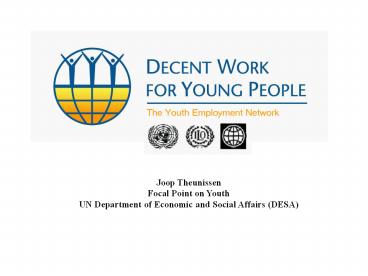Joop Theunissen - PowerPoint PPT Presentation
Title:
Joop Theunissen
Description:
Reading literacy of 15 year-olds. Math literacy of 15 year-olds. Science literacy of 15 year-olds ... in need of jobs every 10 years = 100 million jobs a year ... – PowerPoint PPT presentation
Number of Views:119
Avg rating:3.0/5.0
Title: Joop Theunissen
1
Joop Theunissen Focal Point on Youth UN
Department of Economic and Social Affairs (DESA)
2
This presentation
- The challenge of youth employment
- Action for youth employment the Youth
Employment Network
3
The Challenge of Youth Employment
4
Why is YE so important?
- Youth is a period of transition and vulnerability
- Vulnerability appears to increase with
globalization and increased competition,
everywhere - Long periods of unemployment have a lasting
impact on youth - Individual level self-esteem, respect, sense of
achievement - Societal integration, cohesiveness, citizenship
5
The Present
- 88 million young people out of work
- 59 million kids (17-19) in hazardous work
- Youth are 41 percent of all unemployed
- Youth unemployment 2-3 times higher than average
unemployment - Source ILO Key Indicators of the Labour Market,
www.ilo.org/kilm. Figures for 2004.
6
The Best-Educated Generation Ever!
- Yet still large differences globally
- 130 million children not in school
- 133 million youth are illiterate
- Large gender differences
- Large differences between groups of countries
(And healthiest ever too.)
7
Education in developing countries
Reach Grade 5 Enrolment in secondary school, M-F Adult literacy rate, M-F
Sub-Saharan Africa 61 26-22 69-54
Middle East / North Africa 91 67-62 75-54
South Asia 59 57-40 66-40
World average 77 66-61 85-74
8
Educational inequalities in developed countries
- We can measure and compare the educational
baggage of young people - Reading literacy of 15 year-olds
- Math literacy of 15 year-olds
- Science literacy of 15 year-olds
- Math achievement of 8th graders
- Science achievement of 8th graders
9
An educational achievement league of 24 rich
countries
The Top 5 The Top 5 Other countries Other countries
1 Republic of Korea 1.4 12 France 12.6
2 Japan 2.2 18 USA 16.2
3 Finland 4.4 19 Germany 17.0
4 Canada 5.0 21 Spain 18.6
5 Australia 6.2 22 Italy 20.2
The table shows average ranks of all five
measures. Source UNICEF Innocenti Report Card
No 4, November 2002.
10
The Future
- Over 1 billion young people in need of jobs every
10 years 100 million jobs a year - 130 million kids not in school now -gt what will
they be in 10 years? - (Importance of MDGs)
- More unemployed young people in urban areas with
little hope for decent work - Globalization gt increased competition between
young people in more countries?
11
2. The Youth Employment Network (YEN)
12
A little history
- Millennium Report of the Secretary-General, 2000
The Millennium Development Goals (MDGs) - Goal 8. Developing global partnerships for
development, including a network to address
decent and productive work for young people - A high-level panel of advisers to the
Secretary-General with support of three
organizations World Bank, ILO and UN
13
YENs 4 Es to address youth unemployment
- Employability investing in education
- Equal opportunities for men and women
- Entrepreneurship start and run businesses
- Employment creation as part of macroeconomic
policy
14
The First E. Employability
- Definition a key outcome of education and
training to instill skills, knowledge and
competencies of workers - Reality high cost of investment, skills mismatch
- Invest in life skills, life-long learning, ICT,
entrepreneurship, SSEs in and out of school
15
The Second E. Equal opportunities for young men
and women
- Before school equal access and entry for boys
and girls - In school tracking out of TVE, career
guidance, double burdens, cultural barriers,
gender stereotyping, harassment - After school credit access, lower skills
- In the job discrimination in pay, training,
promotion
16
The Third E. Entrepreneurship
- Cultural attitudes negative perceptions of
entrepreneurship, corruption, social
entrepreneurship - Education a system that stimulates
entrepreneurial spirit, teachers training - Skills training career training, ICT
- Business support skills and services to run your
own firm - Regulation taxes, laws and burocracy
- Finance youth as risky investments
17
The Fouth E. Employment creation
- Yes, it is the economy that creates jobs!
- Labour market policies
- Macro-economic policies
- Exchange rate policies
- Sectoral policies
- External economic shocks, disasters and wars
- Institutional support for youth employment
governance, national employment strategy,
monitoring
18
Whats next
- National action plans for youth employment by
March 2004 - Mobilizing financial resources for youth
employment - Linking youth employment with education
- Expanding on youth participation in policy and
action No decision making without youth
participating
19
Unemployment is the problem.
Youth are the solution.
20
Thank you! www.ilo.org/yen































